Learning objectives
After you have completed this topic, you should have knowledge of:
- Posting from the General Journal to the General Ledger
- Posting from the Cash Receipts Journal and Cash Payments Journal to the General Ledger
- Posting from the Sales Journal and Sales Returns and Allowances Journal to the General Ledger
- Posting from the Purchases Journal and Purchases Returns and Allowances Journal to the General Ledger
- Standard Industry Banking Procedures and Guidelines
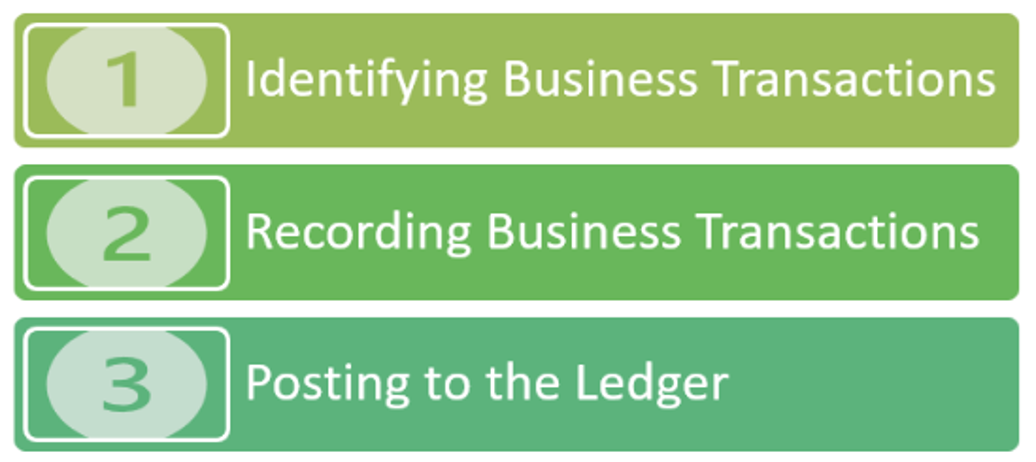
The third step in the accounting cycle is posting transactions to the ledger.


The chart of accounts is a listing of all accounts used in the general ledger of a business. All transactions of a business are recorded in the an accounts contained in the chart of accounts. The chart of accounts contains a list of account names with a unique account number grouped together with . When creating a chart of accounts, it should be flexible enough for the business to allow for the business to grow.
Example of a Chart of Accounts

The general ledger is a chronological list of all the transactions of a business.
A general ledger has four primary components: a journal entry, a description, debit and credit columns, and a balance.
- Journal entry - The journal entry posted to the account and the date of the entry.
- Description - A description of the transaction.
- Debit and credit columns - Each journal entry posts a debit or credit to the general ledger.
- A balance - If a business uses a running balance general ledger, the general ledger lists the account balance each time a debit or credit is posted to the account. If a business uses a T account general ledger at month-end, after all the journal entries are post, the ending balance is calculated.
The process of transferring a transaction from a journal to the ledger is called posting.
The following video explains the process of posting transactions to the ledger accounts.

The general journal is the easiest journal to post to the general because the journal tells you which ledgers to post to and the debit and credit amounts.
A ledger account is created for each account listed in the chart of accounts. General journal entries are posted directly to the ledger accounts affected.

The date of entry in the general journal is the same date used in the ledger.

Total debit entries are equal to the total credit entries.
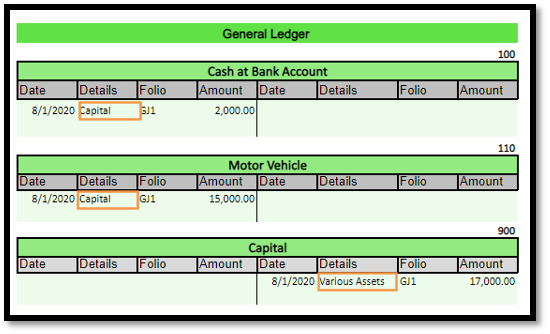
The information in the details column of the ledger account is cross-referenced to the other account/s affected by the transaction. A cross-reference to the general ledger is useful as it provides additional information on each amount recorded.

The folio column in the general journal is used to track the ledger account the transaction has been posted to and vice versa.

The cash receipts journal records all cash, cheque and EFT amounts received. Amounts received can be from sales, interest received, debtors or commission received.
When posting from special journals (cash receipts, cash payments, sales, sales returns, purchases and purchases returns), the heading of each column is usually the name of the ledger that you post the account to, and the column total is usually the amount posted.
Discount allowed represents a discount the business offers to their customers for prompt payment. A discount reduces the amount of the sale, which also results a reduction in the GST the business receives from its customers and, in turn has to pay to the ATO.
To help you identify which general ledger account you need to post transactions to, analyse the transactions in a table before you post them. By doing this, you can ensure the debits will equal the credit and the accounting equation stays in balance.

Once you have identified which accounts need to be debited and which accounts need to be credited you post the transactions to the general ledger accounts. The posting to the general ledger is illustrated below.
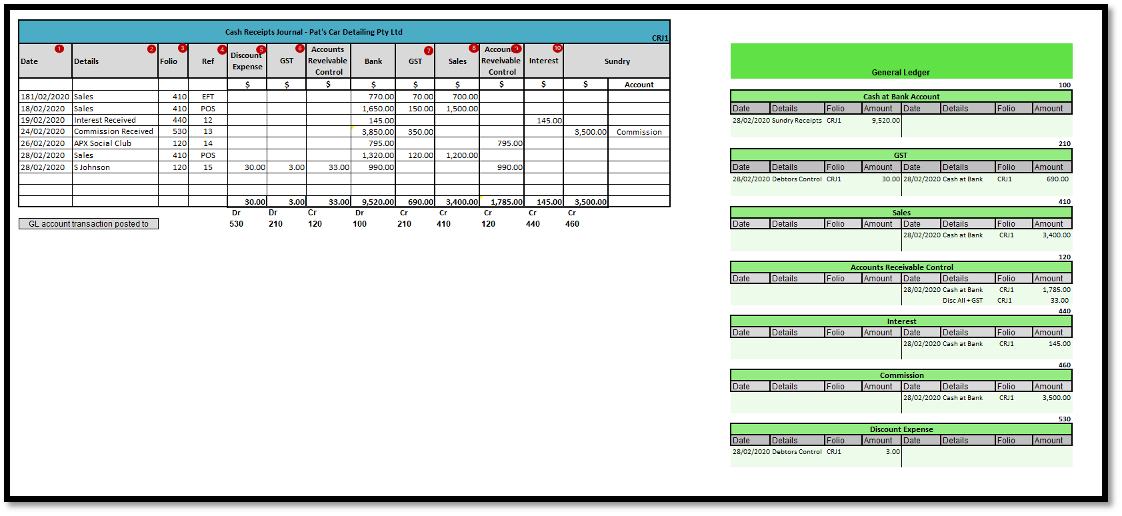
The last date in the cash receipts journal is used when posting to the general ledger.
The sundry account column in the cash receipts journal is used to record the ledger account sundry items are posted to. In the example above, this is the commission ledger account.
The folio in the general ledger is used to cross-reference the journal (CRJ1).

The cash payments journal records all payments. These include payments for wages and salaries, suppliers and expenses.
When posting from special journals (cash payments, cash receipts, sales, sales returns, purchases and purchases returns), the heading of each column is usually the name of the ledger that you post the account to, and the column total is usually the amount posted.
Discount received represents a discount the business receives from its suppliers for prompt payment. A discount reduces the amount of the sale, which also results a reduction in the GST the business must pay the supplier.
To help you identify which general ledger account you need to post transactions to analyse the transactions in a table before you post them. By doing this, you can ensure the debits will equal the credit and the accounting equation stays in balance.

Once you have identified which accounts need to be debited and which accounts need to be credited, you post the transactions to the general ledger accounts. The posting to the general ledger is illustrated below.
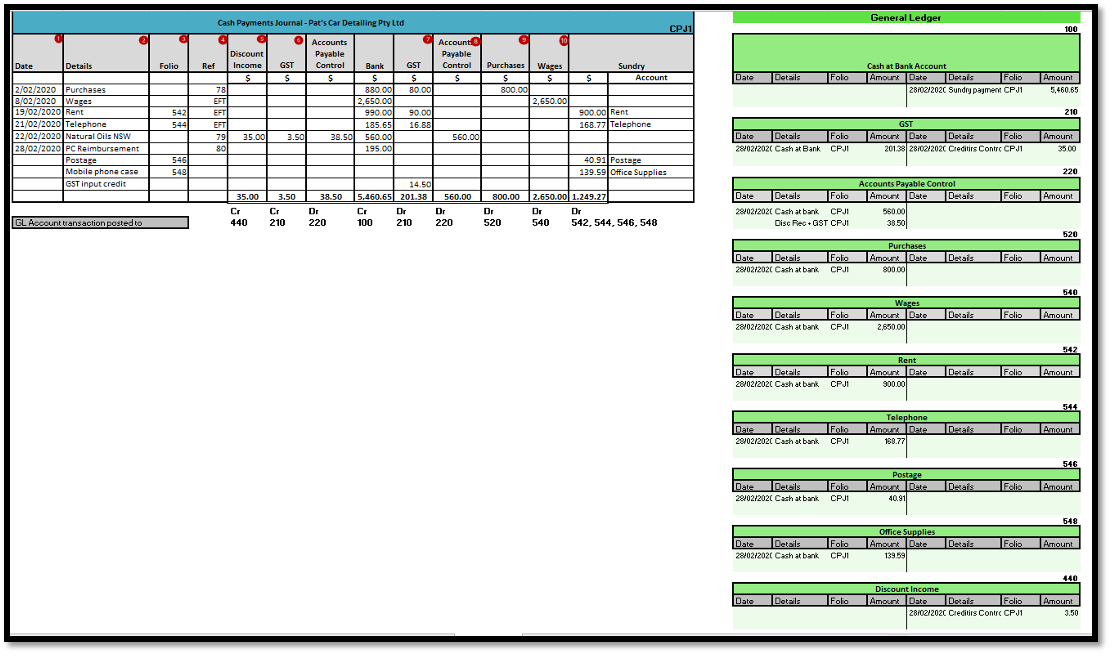
The last date show in the cash payments journal is used when posting to the ledger.
The transactions in the sundry column are posted separately to the individual ledger accounts.
The journal ref in the ledger is used to cross-reference the journal (CPJ1).
Petty cash transactions are posted in the same way as other payments in the cash payments journal.

Sales Journal
Posting from the Sales Journal
When posting from special journals (sales, sales returns, cash receipts, cash payments, purchases and purchases returns), the heading of each column is usually the name of the ledger that you post the account to, and the column total is usually the amount posted.
To help you identify which general ledger account you need to post transactions to, analyse the transactions in a table before you post them. By doing this, you can ensure the debits will equal the credit and the accounting equation stays in balance.

- Instead of having individual ledger accounts for each individual debtor in the general ledger, we post to the accounts receivable control account in the general ledger.
- The posting date is the last day of the period.

- The information in the Details column of the ledger account is cross-referenced to the other ledger account/s affected by the transaction.
- The Folio column is used to track the sales journal account the transaction was posted from.
- The total of the Sales column is posted to the sales ledger.
- The total of the GST column is posted to the GST ledger.
- The total of the Accounts Receivable Control column is posted to the Accounts Receivable Control account in the general ledger.
Posting from the Sales Returns and Allowances Journal
When posting from special journals (sales, sales returns, cash receipts, cash payments, purchases and purchases returns), the heading of each column is usually the name of the ledger that you post the account to, and the column total is usually the amount posted.
To help you identify which general ledger account you need to post transactions to, analyse the transactions in a table before you post them. By doing this, you can ensure the debits will equal the credit and the accounting equation stays in balance.

- Instead of having individual ledger accounts for each individual debtor in the general ledger, we post to the accounts receivable control account in the general ledger.
- The posting date is the last day of the period.
- The information in the Details column of the ledger account is cross-referenced to the other ledger account/s affected by the transaction.
- The Folio column is used to track the sales returns, and allowances journal account the transaction was posted from.
- The total of the Sales returns and Allowances column is posted to the sales returns and allowances ledger.
- The total of the GST column is posted to the GST ledger.
- The total of the Accounts Receivable Control column is posted to the Accounts Receivable Control account in the general ledger.


The purchases journal records all credit purchases of goods or services. The purchases returns journal records credit received from suppliers for goods returned or other allowances for overcharges.
Posting from the Purchases Journal
When posting from special journals (sales, sales returns, cash receipts, cash payments, purchases and purchases returns), the heading of each column is usually the name of the ledger that you post the account to, and the column total is usually the amount posted.
To help you identify which general ledger account you need to post transactions to, analyse the transactions in a table before you post them. By doing this, you can ensure the debits will equal the credit, and the accounting equation stays in balance.

- Instead of having individual ledger accounts for each individual creditor in the general ledger, we post to the accounts payable control account in the general ledger.
- The posting date is the last day of the period.
- The information in the Details column of the ledger account is cross-referenced to the other ledger account/s affected by the transaction.
- The Folio column is used to track the purchases journal account the transaction was posted from.
- The total of the Purchases column is posted to the purchase’s ledger.
- The total of the GST column is posted to the GST ledger.
- The total of the Accounts Payable Control column is posted to the Accounts Payable Control account in the general ledger.

Posting from the Purchases Returns and Allowances Journal
When posting from special journals (sales, sales returns, cash receipts, cash payments, purchases and purchases returns), the heading of each column is usually the name of the ledger that you post the account to, and the column total is usually the amount posted.
To help you identify which general ledger account you need to post transactions to, analyse the transactions in a table before you post them. By doing this, you can ensure the debits will equal the credit, and the accounting equation stays in balance.
- Instead of having individual ledger accounts for each individual debtor in the general ledger, we post to the accounts receivable control account in the general ledger.
- The Posting Date is the last day of the period.
- The information in the Details column of the ledger account is cross-referenced to the other ledger account/s affected by the transaction.
- The Folio column is used to track the purchases, returns and allowances journal account the transaction was posted from.
- The total of the Purchases Returns and Allowances column is posted to the purchases returns and allowances ledger.
- The total of the GST column is posted to the GST ledger.
- The total of the Accounts Payable Control column is posted to the Accounts Payable Control account in the general ledger.


Selecting appropriate deposit facility
Standard Industry Banking Procedures and Guidelines
When processing financial transactions through the cash payments and cash receipts, particularly when it comes to processing banking documents and preparing deposit facilities and lodging flows, it is important to follow standard industry banking procedures and guidelines.
The Australian Bankers’ Association has published the Code of Banking Practice, which sets out obligations and good practices that banks must adhere to when dealing with customers. These obligations and practices cover the following:
- Account suitability
- Terms and conditions
- Direct debits and chargebacks
- Privacy and confidentiality
- Joint debtors
- Guarantees
- Provision of credit
- Financial difficulty and debt collection
- Dispute resolution
In addition to following standard banking procedures, individuals working in the accounting and bookkeeping industry also have to follow standard industry banking guidelines. Examples of these guidelines include:
- Australian Banking Association Financial Services Sector Guidelines
- Protecting vulnerable customers from potential financial abuse
- Promoting understanding about banks’ financial hardship programs
Following these standard banking procedures and guidelines includes ensuring that the corresponding proof of lodgment is obtained for each deposit method used. Examples of proof of lodgments for different deposit methods are found in the table below.
| DEPOSIT METHOD | PROOF OF LODGEMENT |
|---|---|
| Online deposit | Transaction list Email verification of transaction |
| Over-the-counter deposit | Bank stamped deposit facility Tearaway part of a deposit slip |
Whenever the business receives cash and cheques, these will need to be physically taken to the branch of the financial institution for depositing. Your organisation will have policies and procedures relating to when and how this is to be done. These procedures are developed to ensure staff members remain safe, and money is protected to the best of their ability.
Preparing accurate bank deposits involves entering and balancing all the different types of payments received.
Some financial institutions provide deposit books for businesses to do their banking which may also be pre-filled with the account name and number, as well as the bank-state-branch (BSB) number.
Deposit information recorded on the form will include:
- The name of the depositor/account holder and the account number
- The bank-state-branch number (BSB)
- The date of deposit
- A total of coin/ notes/ cash
- The total value of the deposit (cash and cheque transactions)
- A listing of the cheques showing drawer, bank and branch of each cheque
- The total of all cheques
- A signature of the person depositing/preparing the deposit
Security and safety precautions
Like any other industry, the financial sector is regulated by legislation and mandatory policies, procedures and guidelines specific to the industry. All organisations and workers within the industry are required to comply with them.
It is important all policies and procedures are closely followed to maintain safety and reduce the risks associated with the task of transporting money to and from a bank.
Customers have a right to privacy. This is a legal right covered by the Privacy and Personal Information Act. This means keeping clients' personal and sensitive information confidential. This Act requires financial sector employees to behave in a careful manner with regard to information. A significant part of the relationship between customers and financial services suppliers is based upon trust. Customers must be comfortable with the concept that their financial institution will always operate in an ethical and legally responsible manner.
If this trust breaks down, there are both legal and business growth consequences for the organisation. Where an employee fails to follow proper procedures, the consequences will impact on their employment and might also have consequences under the law.
Threats to your computer
Each and every time you log onto the internet, your computer is at risk of various threats with the aim of getting your personal details and accessing your money.
Behind the scenes, we use various security measures to ensure that your transactions and personal information are protected. However, you, as a customer, can also play a big part in protecting your banking and personal information. The first step in that process is to understand the main threats to your computer.
![]()
Banking Fraud
As a customer, you may be seen as a potential target for fraudulent activities. However, by arming yourself with information and tools, you can protect yourself from becoming a victim of fraud.
Do you know the four biggest fraud threats you face?
- Electronic fraud
- Identity theft
- Credit/Debit card fraud
- Cheque fraud.
Credit Card And Debit Card Fraud

Credit card and debit card fraud is a crime whereby your credit or debit card can be reproduced in order to use the credit balance to obtain a financial advantage. The creation and/or alteration of a credit/debit card occurs when the information contained on the magnetic strip is reproduced. This type of crime is known as ‘skimming’.
Credit or debit card fraud can also occur when your card is lost or stolen and used by a third party to purchase goods with those cards or to remove cash from the cards.
Credit or debit cards can also be intercepted in transit while being sent to you. Your cards can also be compromised by a dishonest merchant who undertakes unauthorised duplicate transactions on your card.
Protect your credit/debit card:
- Memorise your personal identification number (PIN). Don't use the same PIN for all your cards, and don't choose your birth date or other easily identifiable numbers that might be on something else in your wallet.
- Check statements and call your credit card issuer immediately if you see anything suspicious on your bill. You could help the company uncover fraud—and save yourself from paying unauthorised charges.
- Do not let your credit card out of your sight at any time – for example, at a restaurant – go with the card.
- Card fraud is not applicable in Australia only – be just as vigilant when travelling overseas; credit card skimming is an international crime.
- Always sign your card in ink as soon as you receive it.
- Keep track of when new and reissued cards should arrive, and call the credit card issuer if they don't come on time.
- Make sure your mailbox is secure and that only you and the postal carrier have access to it.
- Tear up all credit card receipts and pre-approved credit card offers into small pieces before you throw them away. Keep your billing statements in a safe place.
- When you use your credit card online, make sure you are using a secure website. Look for a small key or lock symbol at the bottom right of your browser window.
- Never give your card number to strangers or telemarketers who call you on the phone. Don't give your card number unless you initiated the call.
Cheque Fraud

What is cheque fraud?
Cheque fraud is the use of a cheque to get financial advantage by:
- altering the cheque (payee/amount) without authority
- theft of legitimate cheques and then altering them
- duplication or counterfeiting of cheques
- using false invoices to get legitimate cheques
- depositing a cheque into a third party account without authority
- depositing a cheque for payment knowing that insufficient funds are in the account to cover the deposited cheque.
How to protect yourself from cheque fraud
- Reconcile your accounts promptly and regularly
- Never sign blank cheques, and only sign cheques after all details have been completed.
- Limit the number of signatures to your account to ensure control.
- Ensure that your signature is not with documents that can be accessed by the general public.
- Keep all cheques secure when not in use to deter theft.
- Don’t leave any gaps in the completion of the payee name amount in words and in figures.
- If cheques are lost or stolen, contact ANZ immediately and ask them to stop payment on the cheque.
- Ensure that any invoices are valid before payment.
- Consider using electronic means of payment (if possible) for high-value payments.
- Ensure that your mailbox is secure to protect your inward cheques.
Electronic Fraud

Email scams and fake websites
A number of customers from Australian financial institutions have been targeted with hoax emails. These emails appear to be genuine bank emails.
Some emails inform the customer that their security details and passwords need to be updated by logging into an authentic-looking but fake website. The purpose of these websites is to obtain your log on details to access your bank accounts.
Others communicate security messages and advise you to install software from the email that checks and removes viruses. By downloading the software, you are, in fact, tricked into downloading a virus.
ANZ will not send you an email asking for your Account Details, Financial Details, or login details for ANZ Phone Banking, ANZ Mobile Banking or ANZ Internet Banking.
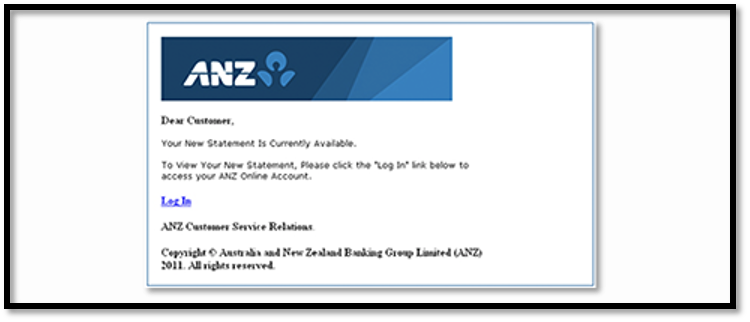
This is an example only; the content and look of the emails change.
Identity Theft

Identity theft is where your personal details are obtained to get some sort of financial or another benefit, leaving you the owner of that identity, often in large debt with a negative credit history and in some cases with legal implications.
Your information can be obtained in many ways:
- Theft, including theft of mail from your mailbox at the home
- By going through your garbage bins
- Telephone, Fax and Mail scams
- Internet.
The following can be used to assume your identity:
- Date of birth
- Utility bills (phone, gas, water and rates notices)
- Address.

